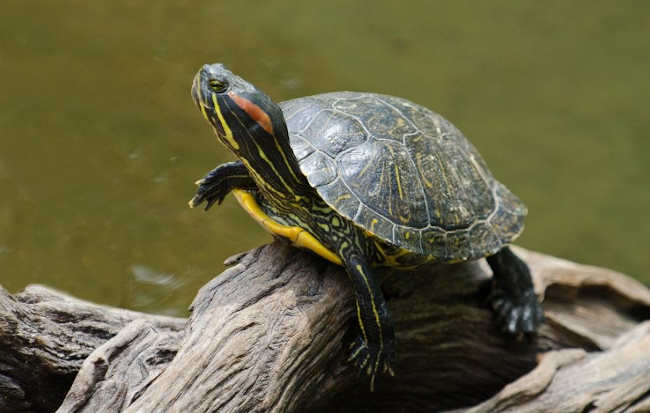
Red-eared sliders
Q: I see turtles all the time in the creeks that run through my neighborhood and the small lake at the local park. How can I tell which turtles are invasive? Should I remove the invasives from the water or leave them alone?
A: There’s a good chance you’re seeing red-eared sliders (Trachemys scripta elegans), which can be common in urban and suburban waterways where people are more likely to release their unwanted pets. Red-eared sliders can thrive in a variety of natural freshwater habitats, including streams, rivers, ponds, lakes, swamps and marshes. They can also be found in artificial habitats such as ditches and canals, and they’re often the only turtle species in urban and suburban park lakes and ponds.
Non-native red-eared sliders can establish self-sustaining populations and reach high densities, and they can compete with native species for habitat and food. For example, in California and the other Pacific states, sliders compete with native western pond turtles (Actinemys marmorata and A. pallida) for basking sites. Red-eared sliders are also vectors of disease and can transmit parasites to native animal species, as well as the bacteria Salmonella to humans.
Red-eared sliders can typically be distinguished from native western pond turtles by the thick red stripe behind each of their eyes, although some individuals lose their colorful skin and shell patterns over time and appear dark overall (melanistic). Unlike the smooth-edged shell of the western pond turtle, the marginal (outer carapace) scutes of red-eared sliders are serrated or slightly forked in appearance. Male sliders have elongated front claws, and are substantially smaller than females as adults. Adult red-eared sliders can range from approximately 5 to 11 inches in length and can live up to 20 years in the wild.
Can you remove a red-eared slider and take it home? Yes, you can capture them using authorized methods named in section 5.60 of CDFW’s freshwater sport fishing regulations. There is no bag limit on sliders, so you aren’t limited to just one; however, the purpose for collection dictates which permit is needed to remove them from the wild. If you want to take them home as pets or for food, a fishing license is required for individuals 16 and over. However, if you are asking about removing them as part of an invasive species control project, you’d need to contact CDFW.
And remember, if you remove a red-eared slider from the wild, you can’t ever release it again – and they can live for up to 40 years in captivity, which is quite a commitment! If you don’t have the resources to keep them at home, and you don’t want to kill them, your best bet might be to take a photo and file an invasive species sighting report with CDFW. If your sighting took place in a waterway where red-eared sliders weren’t previously known to exist, this information is especially useful to biologists, who might opt to remove them before they become established.
Tule elk
Q: How many tule elk are there in California?
A: There are currently about 6,000 tule elk persisting in 22 recognized populations scattered throughout the state. California’s other two sub-species of elk are Rocky Mountain and Roosevelt. For more information, please visit CDFW’s elk webpage.
California bears
Q: I live in the foothills of the Sierra Nevada and a neighbor of mine said she’s seen a grizzly bear in the wild. Is that possible?
A: Black bears are the only wild bears in California. However, they do come in many different colors, from solid black to shades of brown and tan. Some have different patches of color, such as a white blaze on the chest or lighter colored muzzles.
People will sometimes claim to have seen a “brown bear.” Generally, the term “brown bear” refers to Ursus arctos, the grizzly bear. California grizzly bears became extinct by the 1920s and only the one on our state flag remains. There are two subspecies of black bears recognized in California: The northwestern or Olympic black bear (Ursus americana altifrontalis) in the northwest corner of California, and the California black bear (Ursus americana californiensis) throughout the rest of California. They are thought to be geographically distinguished from each other by the crest of the Klamath Mountains.
California’s black bear population is robust and has increased over the past 25 years. Since the extinction of the California grizzly, black bears have been able to expand throughout much of the state as they no longer face direct competition from the larger bear species. For more information, please visit CDFW’s black bear webpage. For resources on co-existing with bears, please see CDFW’s Keep Me Wild webpage and Bear Naked Truth blog.

 How to resolve AdBlock issue?
How to resolve AdBlock issue? 



